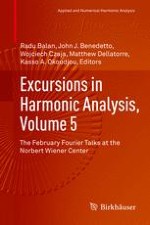This volume consists of contributions spanning a wide spectrum of harmonic analysis and its applications written by speakers at the February Fourier Talks from 2002 – 2016. Containing cutting-edge results by an impressive array of mathematicians, engineers, and scientists in academia, industry and government, it will be an excellent reference for graduate students, researchers, and professionals in pure and applied mathematics, physics, and engineering. Topics covered include:
Theoretical harmonic analysis
Image and signal processing
Quantization
Algorithms and representations
The February Fourier Talks are held annually at the Norbert Wiener Center for Harmonic Analysis and Applications. Located at the University of Maryland, College Park, the Norbert Wiener Center provides a state-of- the-art research venue for the broad emerging area of mathematical engineering.
